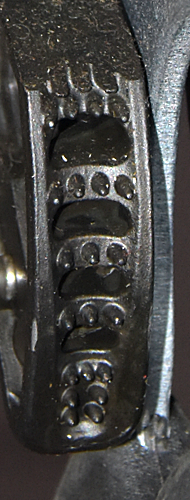Technical Details
I acquired my Kong Procave from Expé-Spelemat in 2008. I acquired another pair in 2017 as part of Bob Thrun’s collection.
The Kong Procave is 161 mm. tall, 119 mm. wide, 27 mm.
thick, and weighs 201 g.
 The shell is a tall irregular shaped stamping made from 3.5 mm. aluminum alloy sheet metal. A 15.0 mm.rope channel is
formed in the upper portion of one side and a smaller cam channel
lies on the other. The rope channel has three 6.8 by 4.8 mm.
relief holes. A hole drilled through both sides of the cam channel
accepts a 6 mm. semi-tubular rivet. The cam and cam spring are mounted
on this rivet. The head of the rivet is on the front of the shell,
and the roll sits in a depression in the rear. The pivot is centered
48 mm. from the inside of the rope channel. The handle below
the cam has a soft "rubbery" hand grip molded into place.
The hand grip has a huge cusp to support the index finger. A 13.7 mm.
sling attachment hole is punched below the handle opening, and
a 9.7 mm. hole is punched below and outside the first. There
are two 3 mm. holes in the shell behind the cam, perhaps
used during manufacture.
The shell is a tall irregular shaped stamping made from 3.5 mm. aluminum alloy sheet metal. A 15.0 mm.rope channel is
formed in the upper portion of one side and a smaller cam channel
lies on the other. The rope channel has three 6.8 by 4.8 mm.
relief holes. A hole drilled through both sides of the cam channel
accepts a 6 mm. semi-tubular rivet. The cam and cam spring are mounted
on this rivet. The head of the rivet is on the front of the shell,
and the roll sits in a depression in the rear. The pivot is centered
48 mm. from the inside of the rope channel. The handle below
the cam has a soft "rubbery" hand grip molded into place.
The hand grip has a huge cusp to support the index finger. A 13.7 mm.
sling attachment hole is punched below the handle opening, and
a 9.7 mm. hole is punched below and outside the first. There
are two 3 mm. holes in the shell behind the cam, perhaps
used during manufacture.
The cam is an oxide-finished skeletonized steel casting. The
cam radius, measured from the pivot, increases from 37 to 57 mm.
over an angle of 42°, giving a 29° cam angle. The cam
has number of small conical teeth, all of which have their axes
approximately parallel to the lower surface of the cam. The tooth
pattern is (3)(4.H)^2(3.H)^2(3.2.2). The H stands for small oval
holes. A spring-loaded manual safety is mounted on an
axle riveted to the bottom center of the cam. The normal action
of the spring holds the safety against the cam. The safety has
a small tab bent outward for the fingers. When the cam is opened,
the shell interferes with the safety, thus preventing cam opening.
At full open the safety can be released and the spring will hold
the tab against the back of the shell, locking the cam open.
The frame has a triangle with an overlapping "!"
stamped behind the cam. The front of the rope channel is printed
with an up-pointing arrow, a rigging illustration, "PROCAVE
DX," and "Ø 8-13 mm."
The rear is printed with the Kong logo, "Italy,"the
UIAA Logo, "CE0426," "EN 567," a book-with-an-"i" icon, and "80386 08 0086."
The Procave is a well-made ascender that performs much like
the Petzl Ascension. All sharp edges
have been removed. The attachment points are simply holes in the
shell, and although rounded, they should have been beveled more.
I consider their small radius too sharp for directly attaching
sling ropes.
The handle is uncomfortable for my large hands, since the huge
cusp digs directly into my middle finger. A file might be able
to fix this. Kong says that the Procave’s dual hadgrip was specially designed for using with both hands. The sloping grip takes some getting used to, but
the handle on handled ascenders is not normally used as
a handle (unless you climb Frog). What matters to me is that
the Procave is wider than necessary.
The relief holes in the shell and cam may allow certain mud
and debris to clear, but really nasty cave mud will overwhelm
any relief capability that these holes provide.
The lower attachment hole has the same potential safety problem
as the one on Clog Version A.
This ascender could theoretically has the same pit lip disadvantage
as the Clog and other stamped frame ascenders.
The shell is thin like the ones on the Camp
Pilot and Kong-Bonaiti, but the
front strap isn't reinforced as it is on those. The handle provides
some reinforcement on the other side, and the ascender is shorter,
so the potential problem may be academic.
The instruction books that came with my Procaves discuss other Kong ascenders, but do not mention or illustrate the Procave.


